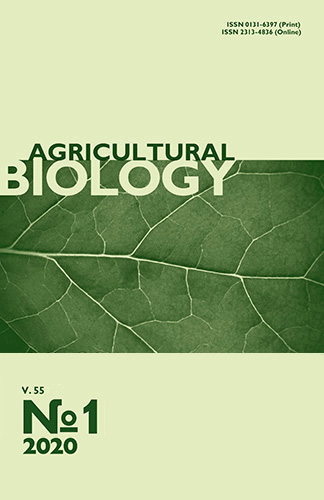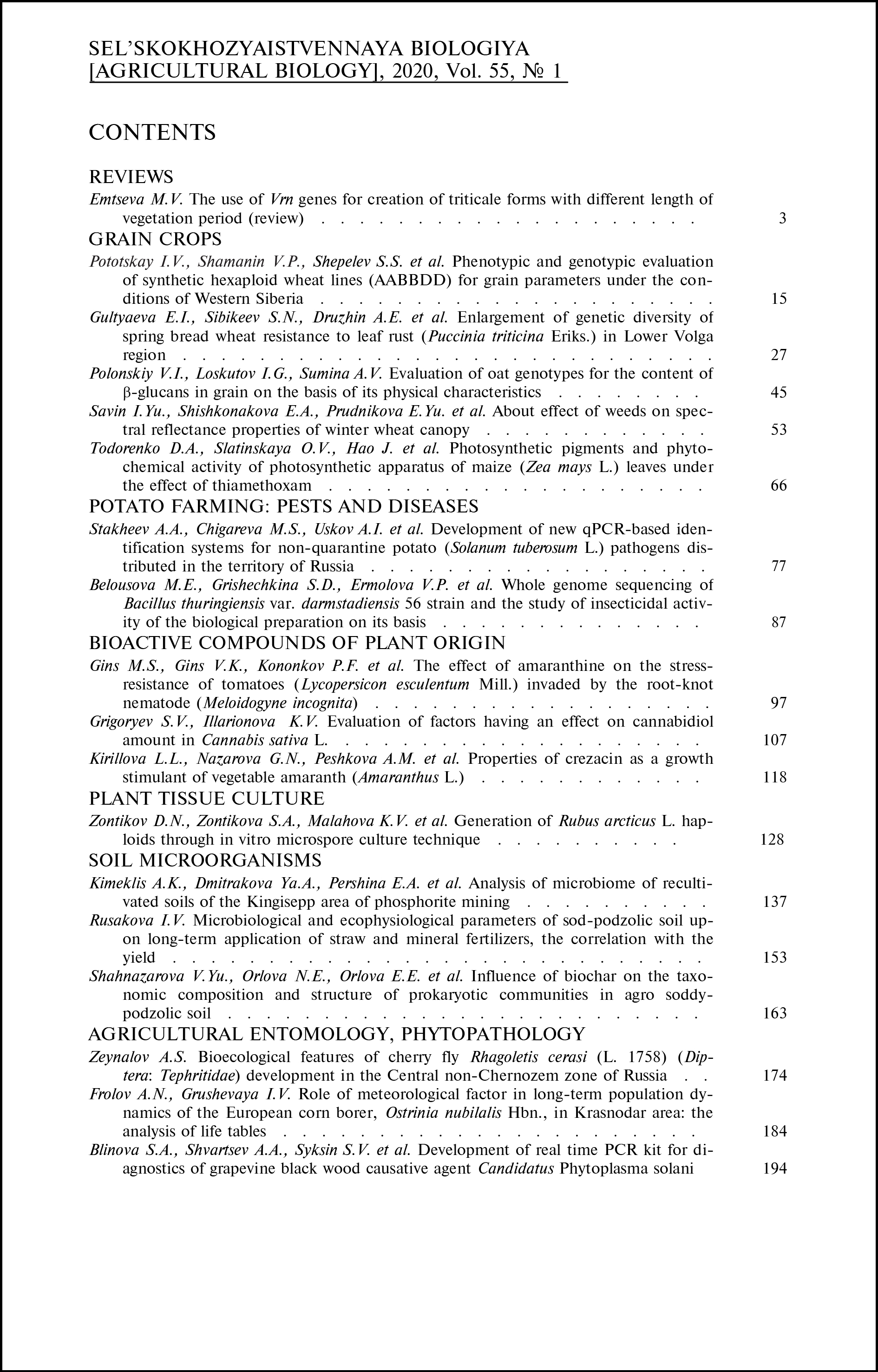doi: 10.15389/agrobiology.2020.1.66eng
UDC: 633.15:581.132
Acknowledgements:
Supported financially by Russian Foundation for Basic Research, grant No. 20-04-00465 А
PHOTOSYNTHETIC PIGMENTS AND PHYTOCHEMICAL ACTIVITY OF PHOTOSYNTHETIC APPARATUS OF MAIZE (Zea mays L.) LEAVES UNDER THE EFFECT OF THIAMETHOXAM
D.A. Todorenko1, O.V. Slatinskaya1, J. Hao2, N.Kh. Seifullina1,
Č.N. Radenović3, D.N. Matorin1, G.V. Maksimov1, 4
1Lomonosov Moscow State University, Faculty of Biology, 1-12 Leninskie Gory, Moscow, 119991 Russia, e-mail dariatodor@mail.ru (✉ corresponding author), slatolya@mail.ru, matorin@biophys.msu.ru, gmaksimov@mail.ru;
2Shenzhen MSU-BIT University, No 299, Ruyi Road, Longgang District, Shenzhen, Guangdong, 518172 China, e-mail haojr@szmsubit.edu.cn;
3Maize Research Institute, Zemun Polje, ul. Slobodana Bajicha 1, 11185 Belgrade-Zemun, Serbia, e-mail radenovic@sbb.rs;
4National Research Technological University MISIS, 4, Leninskii prosp., Moscow, 119049 Russia, e-mail gmaksimov@mail.ru
ORCID:
Todorenko D.A. orcid.org/0000-0002-7344-0256
Radenovich C.N. orcid.org/0000-0001-7218-9015
Hao J. orcid.org/0000-0003-4256-5969
Matorin D.N. orcid.org/0000-0002-6164-5625
Slatinskaya O.V. orcid.org/0000-0002-9908-2637
Maksimov G.V. orcid.org/0000-0002-7377-0773
Seifullina N.Kh. orcid.org/0000-0002-6313-794X
Received July 30, 2019
In the last decade, neonicotinoid insecticides have been actively used to protect plants from pests. Moreover, their effect on the plants, in particular on the state of photosynthetic pigments, has been studied paucity. In the present work, it was shown for the first time that treatment of maize (Zea mays L.) leaves with a thiamethoxam (TMX) insecticide leads to a decrease in the functional activity of photosystem II and a decrease in the energyzation of thylakoid membranes. In addition, the effect of thiamethoxam depends on the genotype of maize. The aim of the work was to study the effect of thiamethoxam pesticide on photosynthetic pigments and the photochemical activity of the photosynthetic apparatus of corn leaves of two genotypes. The experiments were carried out in 2018-2019. The object of the study was samples of maize leaves of the inbred line zppl 225 and hybrid zp 341 with high rates of germination, grain quality and yield (Institut za kukuruz “Zemun Polje”, Belgrade, Serbia). The seeds were germinated until the roots appeared (length not less than 5 mm), after which they were planted in the soil (vermiculite:chernozem mixture, 1:1) and grown under 16-hour daylight at a constant temperature of 25 °С. When the third true leaf appeared (more than 4 cm in length), the plants were sprayed with a TMX solution at a concentration of 0.2 mg/l. Plants grown under similar conditions without TMX spraying were used as controls. The measurements were carried out when the fifth true leaf reached a size of 12-14 cm. The content of photosynthetic pigments (chlorophyll a, b and carotenoids) was determined spectrophotometrically in 100 % acetone extract and calculated using the Holm-Wetstein formula. A change in the conformation of carotenoid molecules was recorded by Raman spectroscopy. Light-induced kinetics of prompt fluorescence (PF), delayed fluorescence (DF) and modulated reflection at λ = 820 nm (MR) were recorded simultaneously using a multifunctional plant efficiency analyzer M-PEA-2 (Hansatech Instruments, Great Britain). PF induction curves (OJIP curves) were analyzed using a standard JIP-test. It was found that in the phase of the fifth true leaf, in the inbred line zppl 225, the chlorophyll content in the presence of TMX decreased from 0.74 to 0.61 mg/g: the amount of chlorophyll a decreased by 17 %, chlorophyll b by 24 %. In contrast, no changes in pigment composition were detected in the leaves of the zp 341 hybrid when exposed to TMX. The OJIP curves of the control and TMX-treated leaves had a typical curve with characteristic O-J, J-I, and I-P phases, which reflected the processes of sequential reduction of carriers in the electron transport chain of photosynthesis (ETC) between two photosystems. The effect of the pesticide on the leaves of two maize genotypes was manifested in a decrease in the functional state of photosystem II, determined by the fluorescence parameter (PIABS), which was obtained based on the analysis of OJIP curves using the JIP-test. Comparison of PIABS in the control and under the influence of TMX revealed statistically significant (p < 0.05) differences: in the leaves of zppl 225 and zp 341 samples treated with TMX, the PIABS parameter decreased by 29 and 24%, respectively. Changes in the fast phase of delayed fluorescence, associated with a decrease in the energyzation of the thylakoid membrane upon exposure to TMX, were detected in the leaves of maize. An analysis of the maximum oxidation and reduction rates of P700 (MR kinetics) indicates a decrease in the acceptor pool on the acceptor side of PSI in zppl 225 leaves when exposed to TMX. It was found that the reaction centers (RCs) of PSI zp 341 showed resistance to TMX (no change in the redox transformations of P700). TMX caused changes in the conformation of carotenoid molecules, but did not change their content in the leaf. The proposed combination of methods for prompt fluorescence, delayed fluorescence, modulated reflection at λ = 820 nm and Raman spectroscopy can be the basis for the formation of an effective technology for the diagnosis of early defects of photosynthetic pigments when pesticides enter an intact plant.
Keywords: Zea mays L., pesticides, Raman spectroscopy, thiamethoxam, chlorophyll, carotenoids, chlorophyll fluorescence.
REFERENCES
- Ensley S.M. Neonicotinoids. Veterinary toxicology (third edition). Basic and clinical principles. R.C. Gupta (ed.). Academic Press, 2018: 521-524 CrossRef
- Georgieva M., Tsenov B., Dimitrova A. Dual effects of N-nitroguanidine neonicotinoids on plants. Genetics and Plant Physiology, 2017, 7(3-4): 107-120.
- da Silva Almeida A., Villela F.A., Nunes J.C., Meneghello G.E., Jauer A. Thiamethoxam: an inseticide that improve seed rice germination at low temperature insecticides. In: Insecticides — Development of safer and more effective technologies. T. Trdan (ed.). IntechOpen, 2013: 417-426 CrossRef
- Shakir S.K., Irfan S., Akhtar B., Rehman S.U., Daud M.K., Taimur N., Azizullah A. Pesticide-induced oxidative stress and antioxidant responses in tomato (Solanum lycopersicum) seedlings. Ecotoxicology, 2018, 27(7): 919-935 CrossRef
- Çavuşoğlu K., Yalçın E., Türkmen Z., Yapar K., Sağır S. Physiological, anatomical, biochemical, and cytogenetic effects of thiamethoxam treatment on Allium cepa (amaryllidaceae) L. Environmental Toxicology, 2012, 27(11): 623-670 CrossRef
- Matorin D.N., Rubin A.B. Fluorestsentsiya khlorofilla vysshikh rastenii i vodoroslei. Moscow-Izhevsk, 2012 (in Russ.).
- Matorin D.N., Todorenko D.A., Seifullina N.Kh, Zayadan B.K., Rubin A.B. Effect of silver nanoparticles on the parameters of chlorophyll fluorescence and P700 reaction in the green alga Chlamydomonas reinhardtii. Microbiology, 2013, 82(6): 809-814 CrossRef
- Kalaji H.M., Jajoo A., Oukarroum A., Brestic M., Zivcak M., Samborska I.A., Cetner M.D., Łukasik I., Goltsev V., Ladle R.J., Dąbrowski P., Ahmad P. The use of chlorophyll fluorescence kinetics analysis to study the performance of photosynthetic machinery in plants.In: Emerging Technologies and Management of Crop Stress Tolerance. V. 2. P. Ahmad, S. Rasool (eds.). Elsevier, USA, 2014: 347-384 CrossRef
- Merlin J.C. Resonance Raman spectroscopy of carotenoids and carotenoid-containing systems. Pure and Applied Chemistry, 1985, 57(5): 785-792 CrossRef
- Tyutyaev E.V., Shutova V.V., Maksimov G.V., Radenovich Ch.N., Grodzinskii D.M. Fiziologiya rastenii i genetika, 2015, 47(2): 147-159 (in Russ.).
- von Wettstein D. Chlorophyll-letale und der submikroskopische Formwechsel der Plastiden. Experimental Cell Research, 1957, 12(3): 427-506 CrossRef
- Strasser R.J., Tsimilli-Michael M., Qiang S., Goltsev V. Simultaneous in vivo recording of prompt and delayed fluorescence and 820-nm reflection changes during drying and after rehydration of the resurrection plant Haberlea rhodopensis. Biochimica et Biophysica Acta (BBA) — Bioenergetics,2010, 1797(6-7): 1313-1326 CrossRef
- Strasser R.J., Tsimilli-Michael M., Strivastava A. Analysis of the chlorophyll a fluorescence transient. In: Chlorophyll a fluorescence: advances in photosynthesis and respiration series, V. 19. G.C. Papageorgiou, Govindjee (eds.). Springer, Dordrecht, 2004: 321-362 CrossRef
- Stirbet A., Govindjee. Chlorophyll a fluorescence induction: a personal perspective of the thermal phase, the J-I-P rise. Photosynthesis Research, 2015, 113(1-3): 15-61 CrossRef
- Lazár D. The polyphasic chlorophyll afluorescence rise measured under high intensity of exciting light. Functional Plant Biology, 2006, 33(1): 9-30 CrossRef
- Nieva F.J.J., Castellanos E.M., Figueroa M.E., Gil F. Gas exchange and chlorophyll fluorescence of C3 and C4 saltmarsh species. Photosynthetica,1999, 36(3): 397-406 CrossRef
- Živčák M., Olšovská K., Slamka P., Galambošová J., Rataj V., Shao H.B., Brestič M. Application of chlorophyll fluorescence performance indices to assess the wheat photosynthetic functions influenced by nitrogen deficiency. Plant, Soil and Environment, 2014, 60(5): 210-215 CrossRef
- Schansker G., Srivastava A., Govindjee, Strasser R.J. Characterization of the 820-nm transmission signal paralleling the chlorophyll a fluorescence rise (OJIP) in pea leaves. Functional Plant Biology, 2003, 30(7): 785-796 CrossRef
- Goltsev V., Chernev P., Zaharieva I., Strasser R.J. Delayed fluorescence in photosynthesis. Photosynthesis Research,2009, 101(2-3): 217-232 CrossRef
- Keri P. Primenenie spektroskopii KR i RKR v biokhimii. Pod redaktsiei B.V. Lokshina [Raman spectroscopy and resonance Raman spectroscopy in biochemistry. B.V. Lokshin (ed.)]. Moscow, 1985 (in Russ.).
- Solovchenko A.E., Merzlyak M.N. Opticheskoe ekranirovanie kak fotozashchitnyi mekhanizm rastenii [Optical shielding as a photoprotective mechanism of plants]. Moscow, 2010 (in Russ.).
- Preetha G., Stanley J. Influence of neonicotinoid insecticides on the plant growth attributes of cotton and okra. Journal of Plant Nutrition, 2012, 35(8): 1234-1245 CrossRef
- Macedo W.R., Araújo D.K., de Camargo e Castro P.R. Unravelling the physiologic and metabolic action of thiamethoxam on rice plants. Pesticide Biochemistry and Physiology, 2013, 107(2): 224-249 CrossRef
- Li L., Chen Xi., Zhang D., Pan X. Effects of insecticide acetamiprid on photosystem II (PSII) activity of Synechocystis sp. (FACHB-898). Pesticide Biochemistry and Physiology, 2010, 98(2): 300-304 CrossRef












